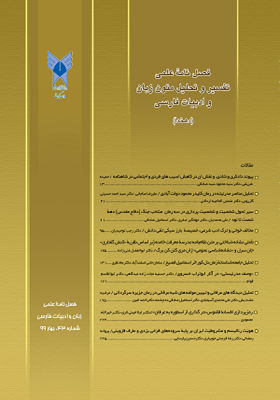تأملی نشانه شناختی بر متن نظامنامه مدرسۀ معرفت خامنه (بر اساس نظریۀ «کنش گفتاری» جان سرل و «نشانهشناسی عمومی» ژان مری کلن کن برگ)
محورهای موضوعی : متون زبان و ادبیات فارسی
1 - استادیار گروه زبان و ادبیات فارسی، دانشگاه پیام نور ، ایران.
کلید واژه:
چکیده مقاله :
یک متن تاریخی؛ میراث ملی. فرهنگی یک جامعه است که در لایههای الفاظ و معانی آن با دست تاریخ رازها و رمزهای گرانبهایی نهفته شده است. دانش نشانهشناسی و فن تحلیل محتوا در انتهای قرن بیستم راهکارهایی را برای درک درست از نهفتگیهای معنایی این نوع متنها فرا راه بشریت قرار داده است.این نوشته با استفاده از دو راهکار کنش گفتاری جان سرل و نشانهشناسی ژان مری متن تاریخی نظامنامه مدرسۀ معرفت خامنه را مورد واکاوی قرار داد.ابتدا از پنج کنش گفتاری جان سرل تعریف اجمالی ارائه شد. سپس با تعریف هنجار عینی و ارزشی به ساختار مرکزمدار و مرکزگریز زبان و کاربرد جغرافیایی، زمانی و اجتماعی آن اشاره رفت و بعد هر سه عکسالعمل؛ خاموشی، بیش تصحیحی و تلافی مورد بحث قرار گرفت؛ تا مقدار امنیت در ارتباط هنجار رایج و هنجار موردنظر زبان معلوم گردد. سپس عبارات متن نظامنامه بر اساس هر دو نظریه یادشده مورد بررسی قرار گرفت و در پایان مشخص شد که کنش گفتاری متن به ترتیب؛ اعلامی، تعهدی یا ترغیبی است و بین هنجارهای رایج جامعه و هنجارهای ارزشی مدنظر متن، ناهمخوانی، عدم امنیت و شکاف وجود دارد.
A historical manuscript is a national-cultural heritage of a community in which valuable secrets are hidden behind the words and concepts. Semiotics and content analysis technique were developed in late 20th century to identify the meaning of the secrets interwoven with the words in such manuscripts.The present study aims at investigating the historical text “workbook of Marefat Khameneh school” using two approaches namely speech act proposed by John Searle and semiology approach proposed by of jean-Marie klinkenberg. In this regard, a brief description is presented about five speech acts proposed by John Searle and then the concepts of “objective and value norms”, “center-oriented and centrifugal” structure of language, and “geographical, temporal and social” applications of language are explained and the three reactions including silences, hypercorrection and compensation are discussed to determine security rate in the relation between common norms and the norm of the language of interest. Afterward, the phrases written in the workbook were investigated using both approaches and it was revealed that speech act of the text is declarative, commisive, and directive; respectively and there is large gap and lack of security between the common norms and value norms embedded in the workbook
_||_

